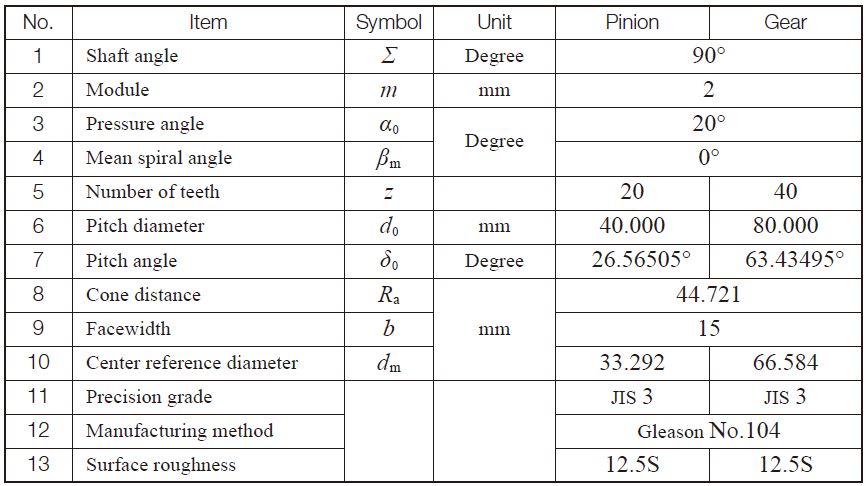D2 – Pitch Diameter of Gear
C – Centre to Centre Distance between the Worm and the Gear
This worm gear design tutorial will discuss up to the selection of the module and pitch and the calculation of the number of teeth, pitch circle diameter and centre to centre distance between the worm and gear. We will use the AGMA formulae for doing the calculations. Design calculations of the other aspects of the worm gear will be discussed in a subsequent part of the tutorial.
Steps of the Design Calculation
- The axial pitch of the worm and the circular pitch of the gear must be same for a mating worm and gear. We will use the term Pitch (P) for both the pitch in this tutorial.
- Also, the module of the worm as well as the gear must be equal for a mating worm and gear.
- Now, let’s say we have the following design input:
Speed of the Worm (N1) = 20 RPM
Speed of the Gear (N2) = 4 RPM
- And, we have to find out the Module (m), Pitch (P), Number of helix of Worm (T1), Number of teeth of Gear (T2), Pitch circle diameter of Worm (D1), Pitch circle diameter of Gear (D2), Centre to centre distance(C).
- Select the suitable module and its corresponding pitch from the following AGMA specified table:
Module m (in MM) – Pitch P (in MM)
2 ————————-6.238
2.5 ———————- 7.854
3.15 ——————— 9.896
4 ————————- 12.566
5 ————————- 15.708
6.3 ———————– 19.792
8 ————————– 25.133
10 ————————- 31.416
12.5 ———————– 39.27
16 ————————– 50.625
20 ————————– 62.832
- Say, we are going ahead with the Module as 2 and the Pitch as 6.238.
- Use the following gear design equation:
N1/N2 = T2/T1
And, we will get:
T2 = 5 * T1……………….Eqn.1
- Now use the following AGMA empirical formula:
T1 + T2 > 40………………Eqn.2
- By using the two equations (Eqn.1 & Eqn.2), we will get the approximate values of
T1 = 7 andT2 = 35
- Calculate the pitch circle diameter of the worm (D1) by using the below AGMA empirical formula:
D1 = 2.4 P + 1.1
= 16.0712 mm
- The following AGMA empirical formula to be used for calculating the pitch circle diameter of the gear (D2):
D2 = T2*P/3.14
= 69.53185 mm
- Now, we can calculate the centre to centre distance (C) by the following equation:
C = (D1 + D2)/2
= 42.80152 mm
- The below empirical formula is the cross check for the correctness of the whole design calculation:
(C^0.875)/2 <= D1 <= (C^0.875)/1.07
Observe that our D1 value is falling in the range.
Conclusion
The worm gear box design calculation explained here uses the AGMA empirical formulas. A few worm gear design calculator are available on web, and some of them are free as well.
In the next worm gear box design calculation tutorial we will discuss the force analysis of a worm gear box.
Related Reading
Helical Gear vs. Spur Gear: If you have observed a spur gear application, you may have noticed that spur gear can be replaced by helical gear. Where should a helical gear should be used? What are the benefits and disadvantages of doing so?
Input Parameters
Teeth type - common or spiral
Gear ratio and tooth numbers
Pressure angle (the angle of tool profile) α
Module m (With ANSI - English units, enter tooth pitch p = π m)
Unit addendum ha*
Unit clearance c*
Unit dedendum fillet rf*
Face widths b1, b2
Unit worm gear correction x
Worm size can be specified using the:
- worm diameter factor q
- helix direction γ
- pitch diameter d1
Auxiliary Geometric Calculations |
Calculated parameters
Common gearing ZN
Axial module | mn = m |
Normal module | mx = mn cos γ |
Axial pressure angle | αx = a |
Normal pressure angle | αn = arctg (tg α cos γ) |
Helix/lead angle | γ = arcsin z1/q |
Spiral gearing ZA
Axial module | mn = mx / cos γ |
Normal module | mx = m |
Axial pressure angle | αn = arctg (tg α cos γ) |
Normal pressure angle | αx = α |
Helix/lead angle | γ = arctan z1/q |
Normal tooth pitch
When we talk about the user interface, the user interface is quite easy and understandable, presenting all the appliances required to bring your system security to the new level. You can check out the specific file, folder, drive (either removable or other) or whole PC. This software will enhance the security against all the types of viruses, malwares, Trojans etc.
Clamxav seriale. The titles of these options will itself explain the use of it. You can run analysis according to your desire i.e.
Axial tooth pitch
Basic tooth pitch
Lead
Virtual/alternate number of teeth
Helix angle at basic cylinder
Worm pitch cylinder diameter
Worm gear pitch circle diameter
Worm outside cylinder diameter
Worm gear outside circle diameter
Worm root cylinder diameter
Worm gear root circle diameter
df2 = d2 - 2m (ha* + c* - x) |
Worm rolling(work) circle diameter
Worm gear rolling(work) circle diameter
Worm gear root circle diameter
Center distance
Chamfer angle of worm gear rim
Worm tooth thickness in normal plane
Worm gear tooth thickness in normal plane
Worm tooth thickness in axis plane
Worm gear tooth thickness in axis plane
Work face width
Contact ratio
Worm Gear Design Guide
εγ = εα + εβ
where:
Minimum worm gear tooth correction
where:
ha*0 = ha* + c* - rf* (1 - sin α) |
c = 0.3 | for α = 20 degrees |
c = 0.2 | for α = 15 degrees |

